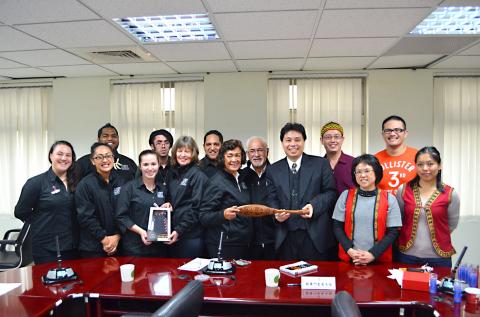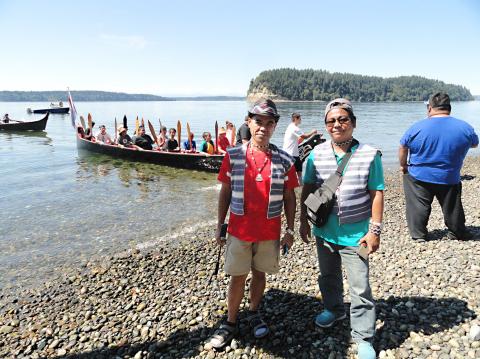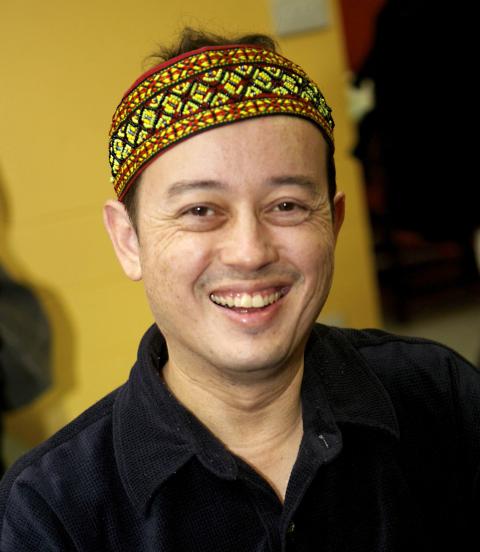ATAYAL aims to launch a new online communication platform to increase dialogue and relations among Aboriginal communities across the globe through media projects, cultural exchanges and tourism, while creating sustainable economic opportunities.
The nonprofit will change their name later this year to “Indigenous Bridges” as a rebranding strategy to emphasize the creation of this digital networking platform, said Tony Coolidge, director of ATAYAL.
Coolidge, whose mother is of Atayal descent, is no stranger to building digital networking platforms. In 2005, after Hurricane Katrina brought much devastation to the US gulf coast, he created the site, KatrinasAngels.org, a database of over 500,000 people that connected victims to volunteers offering housing and aid. A similar approach will be employed in ATAYAL’s online network.

Photo courtesy of Tony Coolidge
“The creation of a system of information management and resource management is something I have been doing for years with other companies and projects. Applying it to indigenous cooperation and development, which is my mission in life, should have been done long ago,” Coolidge said.
SOLVING PROBLEMS
With better online communications and international cooperation among Aboriginal communities, it is possible to solve the problems they face, including discrimination, marginalization and extreme poverty. Aboriginal culture, languages, belief systems and ways of life are under threat, and in some cases have become extinct.

Photo courtesy of Gary Smoke
Even though each Aboriginal communities throughout the globe have their own unique concerns, they share similar historical experiences and contemporary issues of how to balance tradition and modernity, said Daya Dakasi, an Atayal and National Chengchi University associate professor of ethnology. He added that through cross-cultural collaboration, Aboriginal communities can share their experiences and learn from others to help them adopt new practices.
“Even if there are no successful cases, we can establish supporting systems for each other,” Daya said.
In order to alleviate these problems, ATAYAL’s database will feature a user-friendly interface where users can find each other and in turn, more projects can be achieved.

Photo courtesy of Tony Coolidge
“There will also be regular online newsletters and online forums to encourage regular communication between the tribal representatives,” Coolidge said.
Members will be able to look for performers for cultural events, academics and specialists for conferences, tourism opportunities and Aboriginal representatives.
“Our hopes are that by tribes working together they can further their own personal relationships and their own culture,” said Gary Smoke, director of international relations at ATAYAL.
ATAYAL will also continue various side projects that focus on strengthening and establishing relationships with other Aboriginal communities. The organization’s side projects include an annual canoe journey with Native American tribes of the US Pacific Coast, collaboration with other organizations to increase tourism to local Aboriginal villages in New Taipei City’s Wulai District (烏來) and Chiayi County’s Alishan Township (阿里山) and inviting delegations from other nations to visit and participate in cross-cultural exchange with Taiwanese Aboriginal communities.
In particular, the canoe journey has been beneficial to ATAYAL because it has strengthened relations between Taiwanese Aboriginal communities and Pacific tribes of the US, said Smoke. The Native Americans were willing to share their resources and knowledge to help Taiwanese Aborigines solve problems surrounding governmental support and environmental policies, he added.
Tana Yagu, an Atayal who is the nonprofit’s cultural ambassador and canoe journey organizer, said the journey can start a cross-cultural dialogue.
“The benefit to meeting in person ... is to learn really deeply, but also build the connections and relationships that make it possible for coalition building, for advocating on each other’s behalf and to highlight our issues.”
ENVIRONMENTAL ISSUES
Native Americans face similar environmental issues as Taiwan’s Aboriginal community and have been able to share their advice in regards to protesting and pressuring the government to uphold environmental policy promises as well as honoring the rights of indigenous peoples, Tana said.
Residents of Orchid Island (Lanyu, 蘭嶼), for example, are still waiting for the removal of 100,000 barrels of nuclear waste, which was deposited by state-run Taiwan Power Co (Taipower) in the 1980’s, Tana said.
There is also the potential that the Native Americans could partner with Taiwan in creating a cable TV channel to highlight indigenous issues around the globe.
“With the support of the Native Americans, it would be quite possible for them to put together their own channel,” Smoke said.
Native Americans are able to generate income from casinos, tourism and government grants, so they have already established their own Native American television channels, Smoke added.
OBSTACLES
Though ATAYAL has ambitions to increase dialogue among Aboriginal communities, there have been some obstacles causing the fruition of these goals to be slow and tedious. First, funding is limited, as ATAYAL does not receive any financial support from the government.
Second, there was also an instance of promises not being upheld, as Taiwan Indigenous Television dropped plans to feature Coolidge’s media projects after a change in management occurred last year.
Coolidge said that though there have been some setbacks, he “hopes there can be a breakthrough. We are going to keep doing what we do, such as sharing our projects with other people.”

Many people noticed the flood of pro-China propaganda across a number of venues in recent weeks that looks like a coordinated assault on US Taiwan policy. It does look like an effort intended to influence the US before the meeting between US President Donald Trump and Chinese dictator Xi Jinping (習近平) over the weekend. Jennifer Kavanagh’s piece in the New York Times in September appears to be the opening strike of the current campaign. She followed up last week in the Lowy Interpreter, blaming the US for causing the PRC to escalate in the Philippines and Taiwan, saying that as

Nov. 3 to Nov. 9 In 1925, 18-year-old Huang Chin-chuan (黃金川) penned the following words: “When will the day of women’s equal rights arrive, so that my talents won’t drift away in the eastern stream?” These were the closing lines to her poem “Female Student” (女學生), which expressed her unwillingness to be confined to traditional female roles and her desire to study and explore the world. Born to a wealthy family on Nov. 5, 1907, Huang was able to study in Japan — a rare privilege for women in her time — and even made a name for herself in the

Would you eat lab-grown chocolate? I requested a sample from California Cultured, a Sacramento-based company. Its chocolate, not yet commercially available, is made with techniques that have previously been used to synthesize other bioactive products like certain plant-derived pharmaceuticals for commercial sale. A few days later, it arrives. The morsel, barely bigger than a coffee bean, is supposed to be the flavor equivalent of a 70 percent to 80 percent dark chocolate. I tear open its sealed packet and a chocolatey aroma escapes — so far, so good. I pop it in my mouth. Slightly waxy and distinctly bitter, it boasts those bright,

“Taiwanese increasingly reluctant to give their lives to defend the island,” trumpeted a South China Morning Post (SCMP) headline last week. The survey asked whether people should be prepared to pay any price — including death — to protect Taiwan and prevent “reunification.” “The poll found that 52.2 percent of those questioned were unwilling to do so — an 8.4-point rise compared with a similar survey carried out two years ago — while 40.8 percent were willing, down four points on the previous survey,” the article said. Treated as anti-Taiwan propaganda, the piece was sent around by the usual pro-China suspects